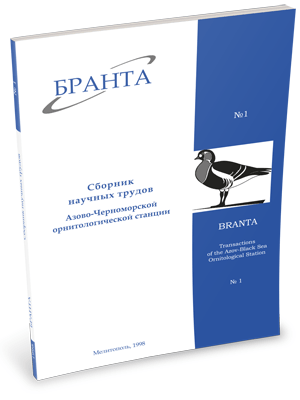
Transactions
of the Azov-Black Sea Ornithological Station



General results of ringing Dunlins in the south of Ukraine
Diadicheva E.A., Chemichko I.I., Matsievskaya N.B., Kinda V.V.
According to the programme of studying migration of waders which has been implemented by the Azov-Black Sea Ornithological Station (Melitopol, Ukraine) mist net trapping and ringing of waders, analysis of number dynamics, age-distribution, biometrics and moult scores were performed for in 1986- 1996. A computer data base containing information on the ringing recoveries from the former USSR area was created. In this paper we describe all available data for this period and analyse some aspects of Dunlin migration through the Southern Ukraine.
Material and methods.Periods of wader catching per year are shown in Figure la,b and main catching areas are presented in Tablel. All spring-autumn catchings include Dunlins; from the middle April up to 20-s May and from 20-s August up to the end of October they were dominant every year. In total 26566 waders were ringed during 1986-1996 years including 13143 Dunlins (Table 2), 645 Dunlin recoveries are analysed (Table 3,4).
Results and discussion. Annual fluctuations of the percentage of juvenile Dunlins in the Sivash area in autumn are shown on Figure 2. The increase in the percentage of juveniles in the years with favourable breeding conditions in the tundras of Western Siberia up to Taimir peninsula (1988, 1991, 1993) and low proportion of juveniles when breeding was unsuccessful (1989, 1992, 1994, 1995) can be seen. Such co-relation between breeding success and age composition during autumn migration allows to suggest that considerable part of both juveniles and adults use the same migratory routes.
According to our recovery data most Dunlins migrating through Ukraine pass across Scandinavia, Poland and Germany during autumn migration in July-August and are retrapped in the Azov-Black Sea region mainly in August- September (during intensive moult). Such a migration route is repeated also in spring. The winter recoveries are mainly from Italy, Tunisia, Egypt, and also
Albania and Greece. Other samples of recoveries are from Dunlins migrating in autumn along the Atlantic coast and wintering there (England, Holland, France). They are controlled in Ukraine only in spring (April-May). There are also 2 birds retrapped between Russia and Ukraine aside to the east of the above mentioned flyways that are supposed to belong to Central or East
Siberian populations migrating straight across continental Russia and Ukraine to the wintering grounds.
Summary. During the 11-уears’ period 13143 Dunlins were ringed by the Azov-Black Sea Ornithological Station and in total 374 recoveries were received in Ukraine and 271 abroad. The Dunlins migrating through the Azov-Black Sea region are likely to use 3 migratory routes: loop flyway passing along Atlantic coast of Western Europe in autumn and only in spring flying across Ukraine; continental European flyway passing across Scandinavia, Poland, Germany, Ukraine to the northern Africa and Mediterranean in autumn and straight across Ukraine to the breeding grounds in Siberia in spring (Chernichko, 1982); continental Euro-Asian fly way from breeding grounds straight to the wintering areas across Russia and Ukraine. In autumn the Sivash has great importance for adult moulting Dunlins so that they deviate to the east from the straight direction of the flight to the wintering grounds.
Read the paper in a PDF file